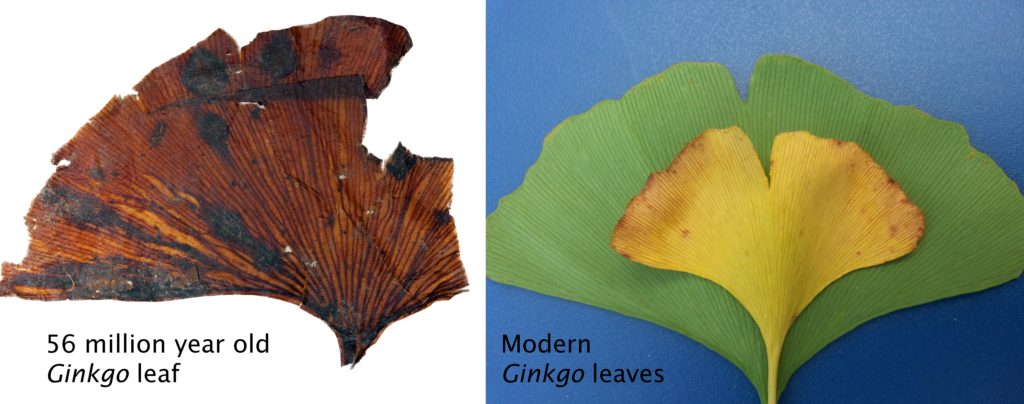United States (Edgewater)
Ginkgo trees evolved before the dinosaurs, survived three mass extinctions, and one species is still living today. Citizen science is helping researchers ask the ginkgo: how will current climate changes affect our home?
Ginkgos have been around for a long time. Their first species evolved before the dinosaurs over 300 million years ago, and today’s ‘living fossils’ still carpet streets around the world with their fan-shaped leaves every autumn. The tough cookies of the tree world, ginkgos are naturally resistant to insects, fungi, and high levels of air pollution, and grow strong roots that can thrive under concrete.
The Smithsonian Institution researchers behind Fossil Atmospheres are now focusing on the wisdom hidden in their leaves to create a record of how the atmosphere has changed through time and better understand how today’s changes in climate are affecting our planet. And you can help!

Living fossils hide ancient secrets. Credit: Sq Lim, Unsplash
We know that Earth has gone through global warming processes before and that the composition of its atmosphere has changed over time. Having a deep understanding of these past changes can help us better predict how the current atmospheric changes and the climate crisis will affect life on Earth in the long term.
Here’s the problem — there is no fossil air from millions of years ago for us to study. But we do have fossils that have lived through important atmospheric changes. And in the case of ginkgo leaves, by simply looking at them we can get a pretty accurate picture of CO2 concentrations throughout history.

Credit: Fossil Atmospheres and Zooniverse
So how can ginkgo leaves tell us all their secrets? To achieve photosynthesis and survival, ginkgos must take in CO2 from the atmosphere and release oxygen and water. This exchange occurs through tiny doughnut-shaped holes in the surface of their leaves, called stomata. To regulate the amount of CO2 entering the leaves and the amount of water vapor escaping, the plant must develop an optimal number of stomata on each leaf (the stomatal index), and this number is heavily affected by the concentration of CO2 in the atmosphere.
The Fossil Atmospheres website explains:
“If we discover exactly how the stomatal index relates to different environmental factors, we could count the stomatal index of a leaf and use it to work out the conditions when it grew. Once we can do this we will be able to use the stomatal index from many leaf specimens collected from different places and geologic time periods to reconstruct a record of how the environment changed through time.”
The Fossil Atmospheres team is especially interested in a specific period of time, the Paleocene-Eocene Thermal Maximum (PETM), which happened 56 million years ago. They explain that during PETM, “a very large amount of carbon dioxide was released into the atmosphere and the average temperature of the planet rapidly increased by about 5 degrees Celsius.”

Meet the stomata. Credit: Fossil Atmospheres and Zooniverse
Since counting the stomatal index takes time, researchers are asking citizen scientists to help. On Zooniverse, you can look at microscopic images of modern and fossil ginkgo leaves and identify stomata cells to help scientists study the history of air on Earth.
At the same time, Rich Barclay, Fossil Atmospheres’ main researcher, is growing Ginkgo trees in specific concentrations of CO2 (about 2.5 times the present atmospheric levels) to see how the plants adapt and the stomatal index varies. Although this was done previously in a lab, Rich hopes that growing “ancient trees in future air” in their natural environment will help us have a better idea of how stomatal numbers on leaves would have varied in real life, and make sure that we take into consideration all environmental factors (such as humidity and temperature) when we draw conclusions from stomatal index data.

Testing future air. Credit: Rich Barclay
AtlasAction: Over 8 thousand volunteers have carried out 78,807 Fossil Atmospheres classifications already. Join them and help researchers track climate change over millions of years.
►Mad for science? Check out more citizen science projects on the Atlas!
Project leader
Rich Barclay
Support the Atlas
We want the Atlas of the Future media platform and our event to be available to everybody, everywhere for free – always. Fancy helping us spread stories of hope and optimism to create a better tomorrow? For those able, we'd be grateful for any donation.
- Please support the Atlas here
- Thank you!

